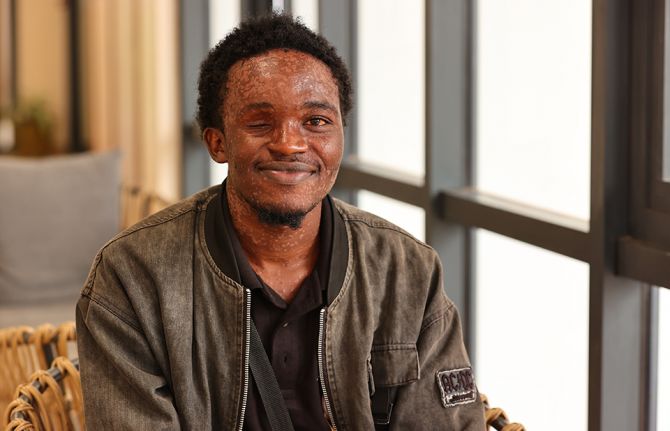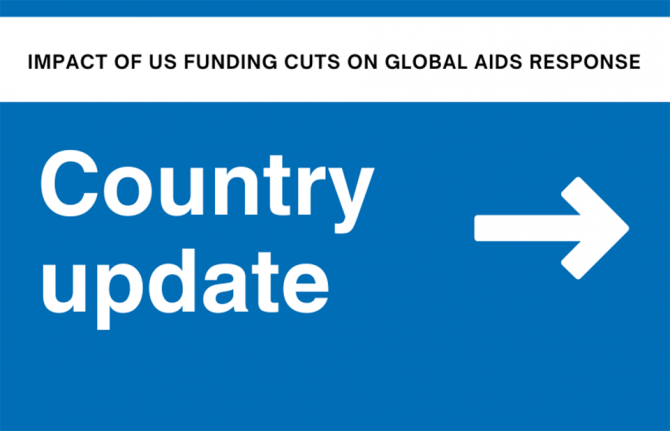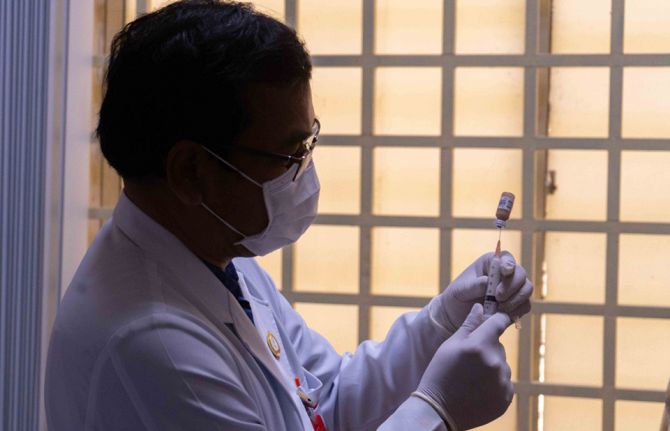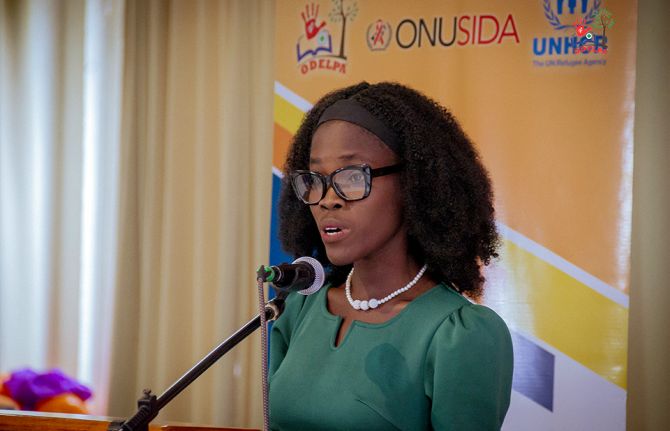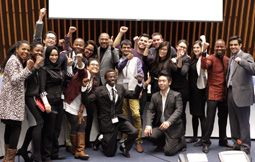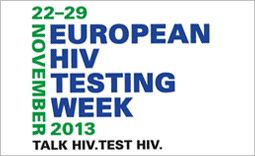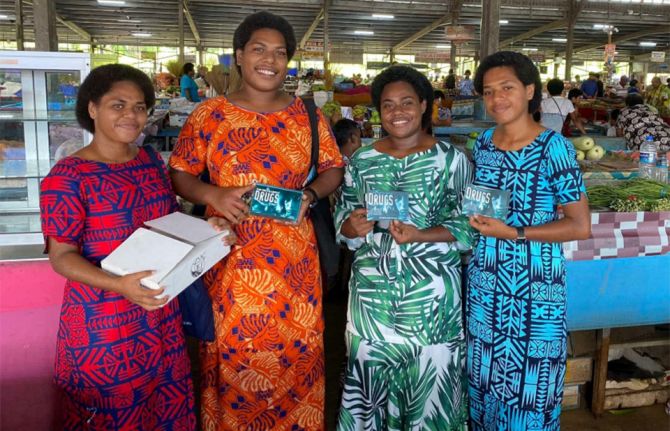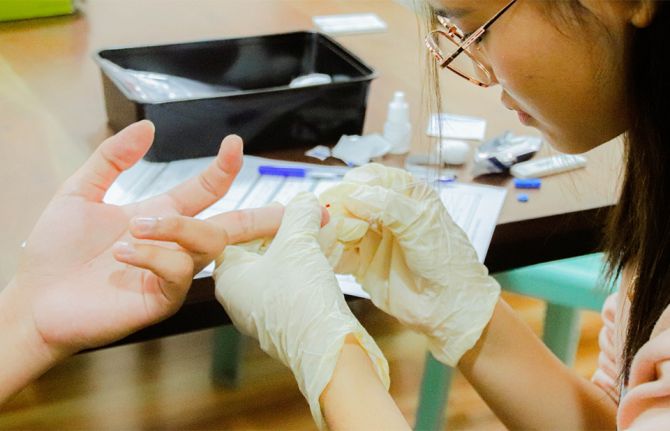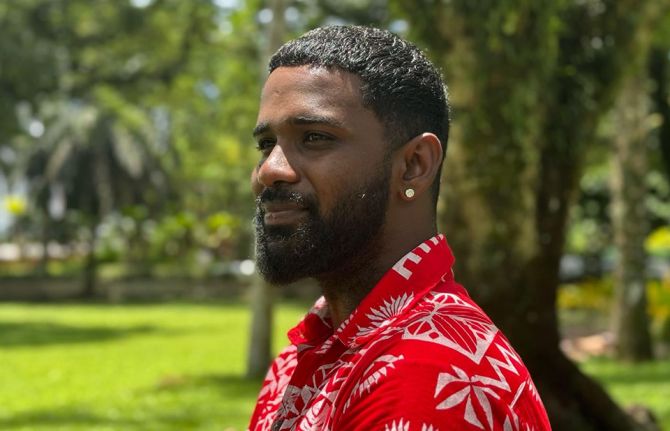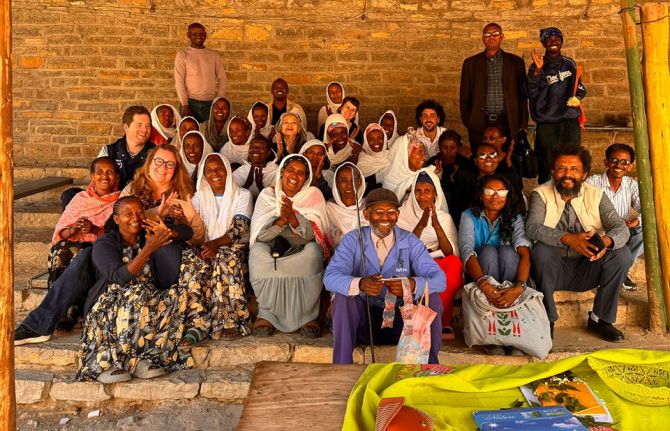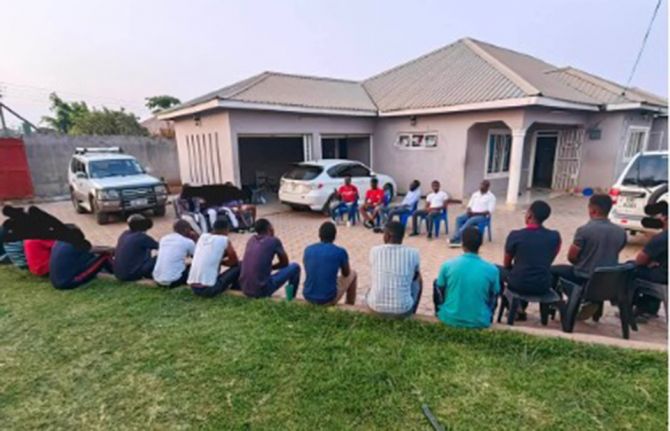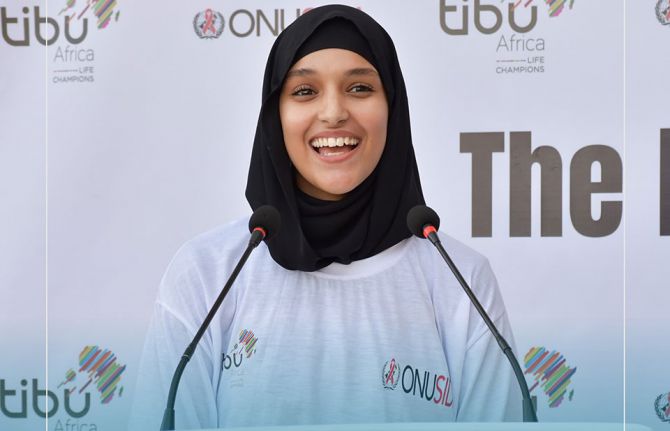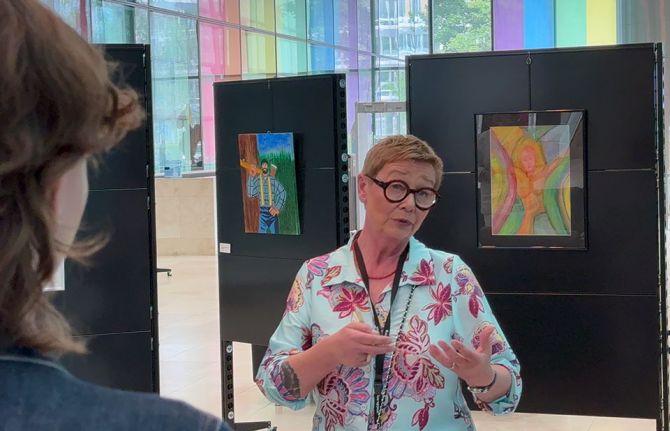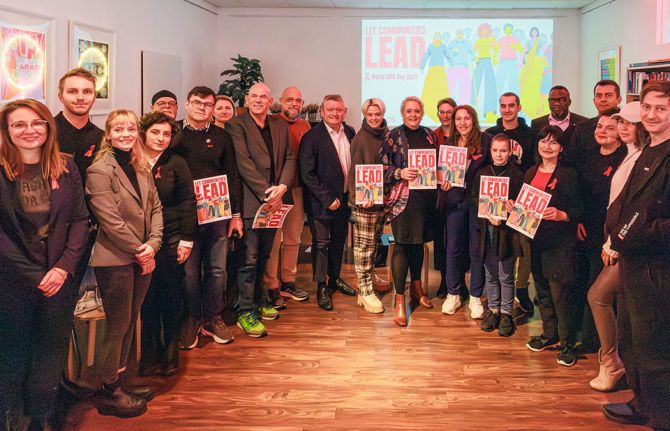
Feature Story
Captains at African Women’s Football Championship ‘Give AIDS the Red Card’ to end mother-to-child transmission of HIV
04 November 2010
04 November 2010 04 November 2010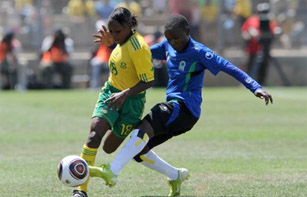
African Women Championship 2010, group A match: South Africa vs Tanzania, 31 October 2010 Credit: CAF
Captains of all eight national teams competing in the 2010 African Women’s Football Championship in South Africa have joined forces to support the Give AIDS the Red Card campaign to end mother-to-child transmission of HIV.
The campaign was initiated during the 2010 FIFA World Cup by UNAIDS Executive Director Michel Sidibé and Kirsten Nematandani, President of the South African Football Association (SAFA). It reinforces global efforts to virtually eliminate mother-to-child transmission of HIV by 2015.
At the opening ceremony of the Women’s Championship on 31 October at Sinaba Stadium in Benoni, South Africa, the captains of the qualifying teams from Algeria, Cameroon, Ghana, Mali, Nigeria, Tanzania and South Africa, publicly read the appeal:
“As captains and players of teams competing in the 2010 African Women’s Championship in South Africa, we appeal to football players and fans across Africa to celebrate life and help prevent mothers from dying and babies from becoming infected with HIV…together we must Give AIDS the Red Card to prevent mothers from dying and babies from becoming infected with HIV.”
Football represents one of the biggest voices in the world and SAFA, as the custodian of football in South Africa, has decided that it will join its voice to the many voices making a difference in the response to HIV around the world
Kirsten Nematandani, President of the South African Football Association
Each year, an estimated 430 000 babies worldwide are born with HIV a large majority in Africa. In many parts of Africa, AIDS-related illness is the leading cause of death among infants and young children. HIV is also the leading cause of death and disease among women of reproductive age worldwide.
Mr Nematandani explained why SAFA is supporting the campaign during this tournament. “Football represents one of the biggest voices in the world and SAFA, as the custodian of football in South Africa, has decided that it will join its voice to the many voices making a difference in the response to HIV around the world.” He concluded, “There is no better way to show this than to articulate it repeatedly during these important championship matches.”
The team captains also committed to read out the appeal at the start of each of the 14 matches that will play in the championship which runs until 14 November 2010.
Related

Feature Story
African HIV prisons network receives prestigious international award
02 November 2010
02 November 2010 02 November 2010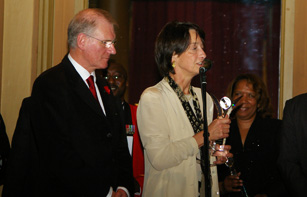
ICPA Executive Director, Mr. Ed Wozniak presenting the award to Dr Fabienne Hariga, Senior Expert, HIV/AIDS Section at UNODC who accepted the award on behalf of the network.
The African HIV in Prisons Partnership Network (AHPPN) has been presented with the prestigious 2010 Healthcare Award by the International Corrections and Prisons Association (ICPA).The award was given during the Association's Annual Conference which took place in Ghent, Belgium from 24 - 29 October.
The Executive Director of ICPA, Mr Ed Wozniak, noted that the award was given in light of the “remarkable and innovative work in the area of HIV of the African HIV in Prisons Partnership Network (AHPPN)”.
The AHPPN is an initiative of the United Nations Office on Drugs and Crime (UNODC). It was created to support governments in their efforts to mount an effective, human rights-based response to HIV and TB in prisons in Africa, and to offer a platform for national, international and multi-sectoral cooperation and action.
According to a 2007 UNODC report existing data suggest high HIV prevalence rates among African prisoners as compared to the general adult population. A study cited in the report indicated HIV prevalence as high as 40% among prisoners in some prisons in South Africa. (The study was conducted in a limited number of prisons and not considered representative of the entire prison population in South Africa.).
Formally launched in November 2009 by UNODC, in partnership with the World Health Organization, the World Bank and UNAIDS, the work of the AHPPN is guided by the belief that ‘good prison health is good public health’.
The network’s efforts include a new website, and has built a comprehensive data collection questionnaire to gather up-to-date and reliable primary source data on HIV in prison settings.
Accepting the ICPA Healthcare Award on behalf of the AHPPN was Dr Fabienne Hariga, Senior Expert, HIV/AIDS Section at UNODC and AHPPN Steering Committee member and Zambian Commissioner of Prisons, Mr Percy Chato.
Related

Feature Story
Progress in Caribbean HIV response, yet punitive laws continue to hamper access to services for most vulnerable
01 November 2010
01 November 2010 01 November 2010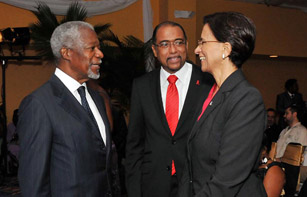
Former UN Secretary-General Kofi Annan (left), UNAIDS Executive Director Michel Sidibé (centre) and Hon Sarah Wescot-Williams, Prime Minister of St Maarten. Credit: UNAIDS
At the 10th annual general meeting of the Pan-Caribbean Partnership Against HIV and AIDS (PANCAP), held in St Maarten, Netherlands Antilles, UNAIDS Executive Director Michel Sidibé joined former UN Secretary-General Kofi Annan and Caribbean leaders to take stock of progress, challenges and lessons learned in the regional response to the HIV epidemic over the past decade.
In his remarks at the opening of the meeting, Mr Sidibé congratulated leaders across the region for keeping HIV high on the development agenda and highlighted the critical role that PANCAP can play in accelerating the HIV response. “PANCAP is the tool for helping us make the call for social justice in the Caribbean,” he said.
According to a new UNAIDS report, The Status of the HIV epidemic in the Caribbean, there were between 210 000 and 270 000 people living with HIV in the Caribbean in 2008. Haiti and the Dominican Republic account for about 70% of all people living with HIV in the region. In the English-speaking Caribbean, Jamaica is the country most affected by the epidemic, with an estimated 27 000 people living with HIV.
The report cites a number of achievements in the regional HIV response. More than 90% of pregnant women in 11 Caribbean countries are now tested for HIV every year. About 52% of pregnant women receive services for the prevention of mother-to-child transmission of HIV, which led to an 18% reduction in new HIV infections among children in 2008.
Governments across the region provided antiretroviral treatment to 51% of people in need in 2008—up from just 1% in 2004. Greater access to antiretroviral treatment is saving lives: since 2001, AIDS-related deaths have dropped by about 40% in the region.
Criminalization of homosexuality
Two-thirds of countries in the Caribbean continue to criminalize homosexuality. Where homophobia is institutionalized in the law, stigma and discrimination against men who have sex with men is pronounced. Homophobia blocks access to HIV prevention programmes and impacts the quality of care for people living with HIV.
Homophobia hurts wherever it haunts—from classrooms to courtrooms
Michel Sidibé, UNAIDS Executive Director
“Imagine yourself as a gay man in such an environment. How confident would you feel about getting an HIV test, or asking for information on prevention or treatment?” asked Mr Sidibé. “Homophobia hurts wherever it haunts—from classrooms to courtrooms,” he added.
HIV prevention not reaching key populations
Among men who have sex with men, HIV prevalence varies from an estimated 6.1% in the Dominican Republic to 32% in Jamaica. HIV prevalence among female sex workers—another key affected population in the region—varies from 2.7% in the Dominican Republic to 27% in Guyana.
According to the UNAIDS report, HIV prevention programmes reach less than 40% of men who have sex with men and less than 50% of female sex workers in the region. Meeting participants agreed that expanding HIV services for those most vulnerable to infection would be critical to an effective regional HIV response.

Feature Story
UNAIDS Goodwill Ambassador Lebo M visits UNAIDS headquarters
01 November 2010
01 November 2010 01 November 2010
Lebo M with UNAIDS Executive Director Mr Michel Sidibe. Geneva. 28 October, 2010. Credit: UNAIDS
UNAIDS International Goodwill Ambassador South African Lebo M, visited the UNAIDS Secretariat headquarters in Geneva last week to participate in a consultation on how to leverage sports and culture for AIDS advocacy. He shared advice from his perspective as a successful producer of global shows including The Lion King and the FIFA 2010 World Cup opening ceremony.
During his stay he also participated in a series of technical briefings on UNAIDS strategy on prevention of mother-to-child transmission of HIV which is an issue that is close to his heart and that he invests time in advocating for. Lebo also had an opportunity to hear about stigma and discrimination and travel restrictions for people living with HIV and was updated on progress towards universal access to HIV prevention, treatment and care and support services.
Lebo met with UNAIDS Executive Director Mr Michel Sidibe and UNAIDS Deputy Executive Directors Dr Paul De Lay and Ms Jan Beagle who expressed their support and encouragement in his advocacy role in the AIDS response as Goodwill Ambassador.
Related

Feature Story
UN Secretary-General Ban Ki-moon visits “one-stop shop” health centre for HIV services in Hanoi, Viet Nam
29 October 2010
29 October 2010 29 October 2010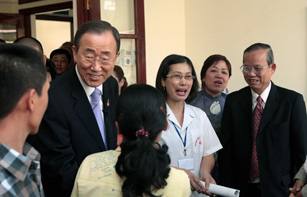
Secretary-General Ban and Viet Nam Deputy Prime Minister H.E. Truong Vinh Trong talking to people living with HIV on Methadone for drug dependence and antiretroviral treatment at Tu Liem health care centre. 29 October 2010. Credit: UN Viet Nam/Doan Bao Chau
United Nations Secretary-General Ban Ki-moon visited a “one-stop shop” health centre for HIV services in Hanoi, Viet Nam on 29 October together with H.E. Mr Truong Vinh Trong, Deputy Prime Minster and chairman of the National Committee on AIDS, H.E. Nguyen Quoc Trieu, Minster of Health, H.E. Nguyen Thi Kim Ngan, Minister of Labour – Invalids and Social Affairs, and H.E. Le The Tiem Vice Minister of Public Security and delegates of the United Nations Country Team.
The HIV epidemic in Viet Nam is concentrated among key populations at higher risk. While HIV prevalence among adults aged 15-49 is estimated at 0.44%, prevalence is significantly higher among men who have sex with men, people who inject drugs and sex workers in the country. For example, HIV prevalence among people who inject drug is about 30%, and in some provinces nearing 50%.
Viet Nam’s HIV response has benefited from the increase in political commitment in recent years. During the visit to the Health Centre, the Deputy Prime Minister, H.E. Truong Vinh Trong highlighted that “Viet Nam is considering turning the national response to HIV into a National Target Programme. This will help ensure the sustainability of the response to HIV and the achievement of the Millennium Development Goal on HIV.”
This health centre is not only preventing the further spread of HIV. You are not just reducing deaths from AIDS in Viet Nam. You are achieving much more. You are giving life to people who will contribute to the development and success of Viet Nam.
Secretary-General Ban
The Tu Liem District Health Centre in Hanoi provides HIV-related services, including HIV counselling and testing, and peer education to key populations at higher risk. The centre also distributes condoms, clean needle and syringes. Recently a government programme was started to provide methadone maintenance therapy, as part of a role out of methadone clinics across the country.
“This health centre is not only preventing the further spread of HIV. You are not just reducing deaths from AIDS in Viet Nam. You are achieving much more,” said Secretary-General Ban to the staff working at the Tu Liem District Health Centre. “You are giving life to people who will contribute to the development and success of Viet Nam.”
Secretary-General Ban also spoke to people living with HIV who were receiving methadone for drug dependence treatment as well as antiretroviral treatment. Many at the centre told the Secretary-General how methadone has changed their lives.
Secretary-General Ban thanked the participants for speaking out on behalf of people living with HIV and he also stressed the importance of addressing issues such as stigma and discrimination to enable people to access HIV services with dignity.
“Viet Nam has significantly scaled up its response to HIV in recent years and has experienced significant progress. I urge the international community to stand by the commitments made to this country to ensure a sustained response to the epidemic and not withdraw their funding,” concluded Mr Murphy, UNAIDS Country Director, speaking on behalf on the UN Country Team.

Feature Story
UNICEF Executive Director launches innovative approach to prevent mother-to-child HIV transmission in Kenya
29 October 2010
29 October 2010 29 October 2010A version of this story has been published at unicef.org

Credit: UNICEF/NYHQ2010-1057/Susan Markisz
UNICEF Executive Director Anthony Lake joined the Government of Kenya and other partners on 29 October to role out an innovative approach to prevent the transmission of HIV from mothers to their babies (PMTCT). The initiative includes a combination of activities and supplies including a “Mother-Baby-Pack” of antiretroviral drugs and antibiotics, which women can easily administer at home.
The “Mother-Baby-Pack” is part of the government’s Maisha mother-to-child transmission free Zone Initiative. This pioneering programme is designed to help virtually eliminate mother-to-child-transmission of HIV and paediatric AIDS by 2013 in Nyanza and Rift Valley provinces, where about half of all Kenyan children with HIV live, and by 2015 in the entire country. Without treatment, around half of all babies born with HIV will die before their second birthday
Mr Lake commended the Kenyan government for its commitment to take ground-breaking steps to expand and strengthen the quality of PMTCT services. “Maisha means ‘Life’ in Kiswahili, and I can think of no better way to describe a programme with the potential to save so many lives,” he said. “The Maisha Initiative is a significant step forward towards our common goal of virtually eliminating mother to child transmission in Kenya.”
Maisha means ‘Life’ in Kiswahili, and I can think of no better way to describe a programme with the potential to save so many lives
Anthony Lake, UNICEF Executive Director
The roll-out in Kenya of the “Mother-Baby-Pack” marks the beginning of a phased implementation in four countries, including Cameroon, Lesotho and Zambia. It is scheduled to run until mid-2011. During this initial phase, UNICEF and its partners will closely monitor the acceptance of the pack by women, as well as the quality of supply and distribution.
The packs were developed by UNICEF in collaboration with the World Health Organization (WHO), UNITAID, and other partners. Health workers in antenatal clinics will distribute them to pregnant women living with HIV, but who do not yet need antiretroviral treatment for their own health. The initiative is designed to reach pregnant women who have tested positive for HIV, but who might not otherwise return to a clinic following their diagnosis.
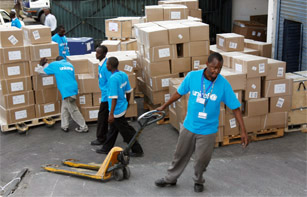
Mother-Baby Packs arrive in Nairobi. They are then loaded onto a UNICEF truck for distribution to other parts of Kenya. Credit: UNICEF Kenya/2010/Joseph Munga
The initiative is supported financially by a number of partners including the US Government, UNICEF National Committees, the Clinton Health Access Initiative (CHAI) and the Mothers-to-Mothers (M2M) programme.
While adult HIV prevalence in Kenya has declined steadily, there are still some 22,000 new infections annually among infants through mother-to-child transmission. Overall, an estimated 1.4 million people are living with HIV in the country, including around 81,000 pregnant women.
Related

Feature Story
UN Secretary-General Ban Ki-moon visits methadone clinic in Cambodia
29 October 2010
29 October 2010 29 October 2010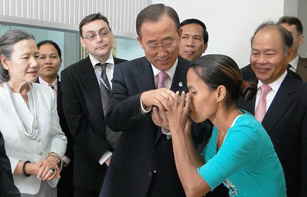
UN Secretary-General Ban Ki-moon hands a methadone dose to a patient at Cambodia's first methadone clinic in Phnom Penh, October 28, 2010
Nearly 10% of global HIV infections are due to unsafe injecting drug use. Sharing contaminated needles and injection equipment can readily transmit HIV. Of the estimated 15.9 million people who inject drugs, 3 million are infected with HIV.
In a recent visit to the first methadone clinic in Cambodia, United Nations Secretary General Ban Ki-moon praised government authorities and health workers for their efforts to reduce HIV infection and drug-related harm among injecting drug users. Launched in July 2010, the clinic has reached, to date, a total of 61 patients.
“This methadone maintenance therapy programme is providing an important service, not just to people struggling to conquer addiction, but to the broader community,” said Secretary-General Ban, after touring the clinic at the Khmer Soviet Friendship Hospital. “Evidence shows that such initiatives are more effective than incarceration in addressing the social problems caused by addiction.”
This methadone maintenance therapy programme is providing an important service, not just to people struggling to conquer addiction, but to the broader community
Secretary-General Ban Ki-moon
Opioid substitution therapy with methadone or buprenorphine is one a number of proven evidence-based measures that reduce HIV infection and drug-related harm, including access to sterile injecting equipment, HIV testing and counselling, antiretroviral therapy, condom promotion to drug users and their sexual partners and community-based outreach.
While countries are increasingly adopting such harm reduction measures, coverage remains poor. According to the UN Reference Group on HIV and injecting drug, only 8% of injecting drug users globally receive opioid substitution therapy and just 4% of HIV-positive injecting drug users receive antiretroviral therapy. Only two needle syringes per injecting drug user are distributed per month.
Experience has shown that law enforcement approaches alone do little to reduce drug use and drug-related crime. Laws criminalizing the possession of injecting equipment or substitution therapy are major barriers in the HIV response, as the fear of criminal measures and prosecution force many drug users underground and lose the opportunity to stabilize their lives.

Feature Story
HIV and conflict: Connections and the need for universal access
27 October 2010
27 October 2010 27 October 2010A Forced Migration Review special supplement

Kibati camp for displaced people, DRC. Credit: Christian Als
The interconnections between conflict and HIV are complex. HIV affects the lives of many people caught up in conflict, including the civilian population but also the protagonists, as well as those whose role it is to provide security during and after conflict.
In conflict, people may be subjected to mass displacement and human rights abuses, including sexual violence, or left in conditions of poverty and powerlessness that might force some individuals to sell sex to survive. In addition, infrastructure may be damaged, and prevention and health services disrupted. Such conditions put populations at increased risk of HIV infection, and women and children are especially vulnerable.
A special supplement on HIV has been published by the journal Forced Migration Review, with support from UNAIDS. This edition is largely based on the work of the AIDS, Security and Conflict Initiative (ASCI), which undertook research over a number of years to gather evidence and advance analysis on the connections between HIV and conflict.
Specially tailored programmes to ensure universal access to vulnerable groups must become an integral part of national HIV policies and strategies, and a key item on the agenda of the international community, according to the article by UNAIDS.
The analysis addresses how to achieve greater and better access to HIV prevention, treatment, care and support for people during and after conflict. It concludes that it is unlikely that Millennium Development Goal 6 will be met without HIV services reaching displaced populations and migrants, regardless of their HIV status, as well as the uniformed services that interact with these populations.
The supplement presents a selection of the ASCI case-studies alongside a number of articles on the subject which were submitted in response to a Forced Migration Review call for articles. UNAIDS and its cosponsors UNFPA and UNHCR as well as various research partners contributed articles. In addition, Dr Nafis Sadik, Special Envoy of the UN Secretary General for HIV/AIDS in Asia and the Pacific authored a piece on the linkages between forced migration and HIV in Asia.
Download the full publication here

Feature Story
African leaders call for accelerated response to AIDS in Zambia
26 October 2010
26 October 2010 26 October 2010
Mr Festus Mogae, former President of Botswana (centre); Professor Miriam Were, former Chairperson of the Kenya National AIDS Control Council (left); and Hon A. K. Mwanamwambwa, Speaker of Zambian National Assembly (right). Credit: UN/Sirak Gebrehiwot
In a recent mission to Zambia the Champions for an HIV-Free Generation, an organization of African leaders which includes former presidents and other influential personalities, met with top government officials to help push Zambia’s AIDS response forward. Zambian President Rupiah Banda unveiled a new National AIDS Strategy in the presence of the Champions that aims to increase access to antiretroviral treatment and reduce HIV infections in Zambia by 50% by the year 2015.
Zambia has one of the highest HIV prevalence rates in the world. According to the latest UNAIDS estimates, 15.2% of the adult population is living with HIV and more than 80,000 adults are newly infected with HIV annually. For every two people who start antiretroviral therapy, an estimated five more become newly infected with the virus.
Led by Mr Festus G. Mogae, former president of Botswana, the delegation of Champions met with government authorities, traditional leaders, civil society representatives, people living with HIV and development partners. Mr Mogae inspired local leaders to strive for virtual elimination of mother-to-child transmission of HIV through the example of Botswana, where rates of infants born to HIV-positive mothers have been reduced from 20% in 2003 to below 4% in 2007.
Culture is important, but if your culture or traditions are killing you, you must think about change
Professor Miriam Were
While in Zambia, the Champions underscored the importance of preventing new HIV infections through proven interventions, including male circumcision and correct and consistent condom use. Gender-based violence and the heavy burden placed on women by HIV were also addressed head on.
“Culture is important, but if your culture or traditions are killing you, you must think about change,” said Professor Miriam Were, a member of the Champions delegation and former Chairperson of Kenya’s National AIDS Control Council.
The Champions held frank discussions on the financial sustainability of the HIV response in the region and the need to move quickly to be effective. “A stick that is far away cannot kill a snake, and if you tap it on the tail and wait for your neighbour to hit it on the head, you will find yourself in trouble,” said Champions delegate Dr. Speciosa Wandira, former Vice-President of Uganda.

Feature Story
UNAIDS convenes consultation on sport for global advocacy
26 October 2010
26 October 2010 26 October 2010
Credit: UNAIDS
Sport has a special ability to unify and galvanize people all over the world and therefore is a powerful vehicle for advocacy at the global down to the community level. In light of the potential of sports for AIDS advocacy, UNAIDS organized a consultation with representatives of several sports organizations and other experts from 24-26 October in Geneva to examine current initiatives and ideas for future activities.
“Sport has tremendous worldwide influence and impact, from the highest level of world championship events to children in remote villages playing with a home-made football,” said UNAIDS Executive Director at the opening of the consultation. “Stronger cooperation with the world of sport can invigorate the global AIDS response in a unique way and help us achieve all the Millennium Development Goals,” he added.
The consultation identified new ways to leverage the convening power of sports to promote HIV prevention, treatment, care and support. Participants also reviewed existing relationships and ways to build and strengthen partnerships between UNAIDS at the global, regional and country-levels, and the world of sports, the private sector, civil society and the media.
UNAIDS has established partnerships with sports personalities and organizations to raise awareness on AIDS issues and to help inform people on how to protect themselves against HIV infection. The 2010 FIFA World Cup initiative “Give AIDS the Red Card”, was backed by international football stars including UNAIDS Goodwill Ambassadors Michael Ballack of Germany and Emmanuel Adebayor of Togo. The campaign used the popularity and the outreach potential of football to unite the world around a common cause—preventing the transmission of HIV from mother-to-child.
Sport has tremendous worldwide influence and impact, from the highest level of world championship events to children in remote villages playing with a home-made football
Michel Sidibé, UNAIDS Executive Director
This week’s consultation provided a forum to review progress around the “Give AIDS the Red Card” campaign and plan for the next phase. It also enabled discussions on future sports initiatives with UNAIDS’ partners including the International Olympic Committee and the International Cricket Council as well as identifying other cooperation opportunities with sports organizations and sports stars and stronger coordination with Cosponsors.
Participants agreed to explore innovative ways to convey HIV messaging through sports. Because the world of music and culture also has great popular appeal, the meeting also considered linkages with sport-related initiatives to amplify the range of the messages.
Other participants included Mr Adolf Ogi, former President of Switzerland and former Special Advisor to the UN Secretary-General on Sport for Development and Peace; Mr Wilfried Lemke, Special Adviser to the UN Secretary-General on Sport for Development and Peace; Mr Krisrten Nematandani, President, South African Football Association; Mr Lebohang Morake (Lebo M), UNAIDS Goodwill Ambassador and producer of the 2010 FIFA World Cup opening ceremony; Ms Katia Mascagni, International Olympic Committee; Mr Chris Hurst, Corporate Communications Manager, International Cricket Council; Mr Amadou Fall, Vice President for Development in Africa of the NBA; Mr Adonal Foyle, Retired NBA basketball player and founder of the Kerosene Lamp Foundation; and, Mr Driss Guerraoui, Adviser to the Prime Minister of Morocco and Convener of the Global Youth Forum.

